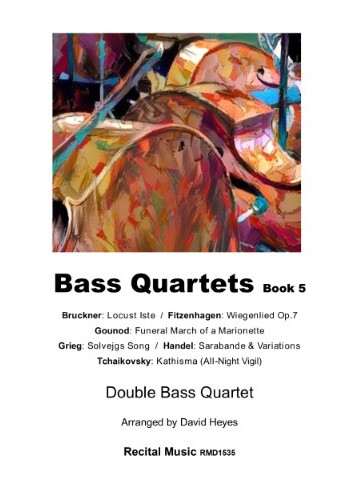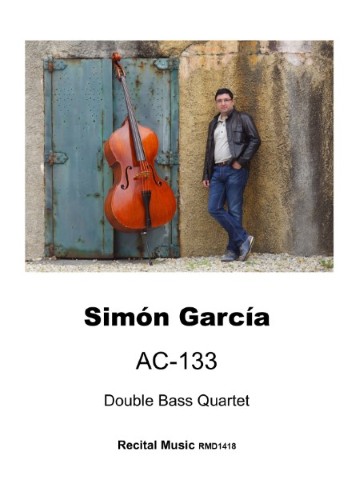Bass Quartets Book 5
6 Pieces for Double Bass Quartet

| Product Code: | RMD1535 |
| Publishers Number: | RMD1535 |
| Series: | Bass Quartets |
| Published date:: | Aug-24 |
| Language: | English |
| Condition: | New |
2. Tchaikovsky – Kathisma (Blessed is the Man)
3. Handel – Sarabande and Variations
4. Bruckner – Graduale: Locus Iste
5. Fitzenhagen – Wiegenlied (Lullaby)
6 Grieg – Solvejg’s Song
Bass Quartets Book 5 is a collection of six inventive and exciting transcriptions from the 18th and 19th centuries which lend themselves beautifully to the…
There are a few musical and technical challenges, alongside opportunities to play wonderfully inspiring music in concert venues or at home with friends.
Bowings and dynamics, alongside dynamics and articulations, can easily be adapted or amended to add further variety and interest.
Some of the pieces have been successfully performed at Bass-Fest and other workshops and concerts, often played by massed forces, and are ideal for the intermediate bass quartet.
The edition includes a score and four solo parts.
1) Charles Gounod (1818-1893) – Funeral March of a Marionette Originally for solo piano or orchestra, this evocative miniature ‘tone poem’ transcribes well for double bass quartet and has great character and energy. There
are few challenges but scope to explore musical and fun sound worlds and to create an expressive musical story. The programmatic storyline is included in the score and parts to help characterise the music and this would be ideal for any bass quartet looking for something lively and engaging with effective musical and technical challenges for each player.
“This is a nice arrangement of the Funeral March of a Marionette for a mixed ability group of basses. Part 1 is all in treble clef and mostly carries the tune, with interjections from the other parts. Part 4 is all in half and first positions but the musical and technical (fast arco/pizz changes) challenges mean it requires an agile performer, even if not hugely advanced. The middle two parts by range look to be Grade 6, but both have their awkward moments technically. I remember teaching this piece when it was set with piano accompaniment for Grade 5, in an arrangement by Andrew Wilson-Dickson, and finding students struggled to make musical sense of it without the piano part. I suspect this chamber music version for bass quartet will make better sense to players. I also like the references to the story ‘The marionette is broken’, ‘Regretful murmurs of the troupe’ and so on throughout the score and parts. I look forward to rehearsing it with my students.” [ESTA – News & Views]
2. Peter Tchaikovsky (1840-1893) – Kathisma (Blessed is the Man) Op.52, No.3 Tchaikovsky?s All-Night Vigil Op.52 was composed in 1881-2 for unaccompanied choir and its seventeen movements use texts taken from the Russian Orthodox all-night vigil ceremony. The chordal writing works particularly well for double bass quartet, or larger forces, helping to develop good ensemble skills in beautifully distinctive and evocative music. A range of dynamics can be added to create variety and contrast.
3. G.F. Handel (1685-1759) – Sarabande and Variations
Suite No.11 in D minor for harpsichord was composed between 1703-1706 and first published in 1733. Its five movements (Prelude, Allemande, Courante, Sarabande, Gigue) are typical of the Baroque suite and in recent times the Sarabande has taken on a life of its own. The imposing and dramatic opening music is contrasted by two inventive and engaging variations, working particularly well for bass quartet, and it has been arranged numerous times including for orchestra, woodwind octet, four accordions, string orchestra or guitar. Different dynamics and articulations can be added to create a unique performance each time.
4. Anton Bruckner (1824-1896) – Graduale: Locus Iste
Locus Iste (This Place) is a sacred motet composed in 1869 and intended for the dedication of the votive chapel at the New Cathedral in Linz (Austria), where Bruckner had been cathedral organist. It begins and ends simply in C major, marked Allegro moderato, and has been described as having Mozartian touches before Brucknerian chordal progressions are introduced. It has also been portrayed as “transparently chromatic” and would work beautifully in a large concert venue or space where the rich chordal progressions are able to resonate and sing.
5. Wilhelm Fitzenhagen (1848-1890) – Wiegenlied (Lullaby) Op.7
German cellist-composer Wilhelm Fitzenhagen was a fairly prolific composer, mainly writing for the cello, and today is remembered as the dedicatee of Tchaikovsky’s
Variations on a Rococo Theme for cello and orchestra. Following a successful career in Europe, Fitzenhagen was appointed professor of cello at the Moscow Conservatoire, becoming one of Russia?s pre-eminent cello teachers. He was equally well known as a soloist and chamber musician, performing in the premieres of Tchaikovsky’s first three string quartets. Wiegenlied was first published in 1873 and is a beautifully lyrical and gently heart-warming piece, recently transcribed for double bass quartet. Emphasising the sonorous and singing qualities of the double bass, the style is late-romantic and elegant, would easily fit into any programme, and is ideal for any audience or occasion.
6. Edvard Grieg (1843-1907) – Solvejg’s Song
Solvejg?s Songs is one of the most beautiful and evocative movements from the incidental music that Grieg composed for Peer Gynt, Henrik Ibsen?s play, in 1875. Originally for orchestra and subsequently arranged for voice and piano, the piece contrasts minor and major keys (G minor/G major) in distinctive music which is instantly appealing. The opening theme is plaintive and melancholic, alternating with music of a more optimistic nature in the tonic major, offering many possibilities for the intermediate bass quartet or ensemble. The melodic material is shared between the four players, including simple and effective chords played in harmonics, with many opportunities to create atmospheric and ethereal sound worlds and moods.
R.R.P £11.50
Our Price: 9.2
Digital Download – PDF
Shipping costs: No shipping
Other books in this series
You might also like
-
3 Quartets
£8.00 -
A Box of Delights for 4 Double Basses
£6.00 -
A Celtic Suite
£8.00 -
AC-133
£6.80







